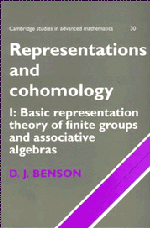Book contents
Chapter 4 - Methods from the representations of algebras
Published online by Cambridge University Press: 26 January 2010
Summary
Representations of quivers
It follows from Morita theory (Section 2.2) that to study the representations of a finite dimensional algebra over an algebraically closed field, it suffices to consider the case where every irreducible module is one dimensional. We shall see that such an algebra is expressible as a quotient of the path algebra of a quiver (directed graph) by an ideal contained in the ideal of paths of length at least two. More generally, a finite dimensional basic algebra over any field can be expressed essentially uniquely as a quotient of a “modulated quiver” by such an ideal, provided certain sequences of bimodules over division rings split (this condition is always satisfied over a perfect field). This makes the representations of quivers important to the study of representations of finite dimensional algebras.
Definition 4.1.1. A quiver is a directed graph, possibly with multiple arrows and loops.
If Q is a quiver and k is a field, we define the path algebrakQ as follows. It is an algebra over k, which as a vector space has a basis consisting of the paths • → • → … → • in Q. Multiplication is given on basis elements by composition of paths in reverse order (because we are dealing with left rather than right modules) if the paths are composable in this way, and zero otherwise. Thus for example corresponding to each vertex x there is a path of length zero giving rise to an idempotent basis element denoted ex. A free algebra is an example of a path algebra, for a graph with only one vertex.
- Type
- Chapter
- Information
- Representations and Cohomology , pp. 99 - 170Publisher: Cambridge University PressPrint publication year: 1991



